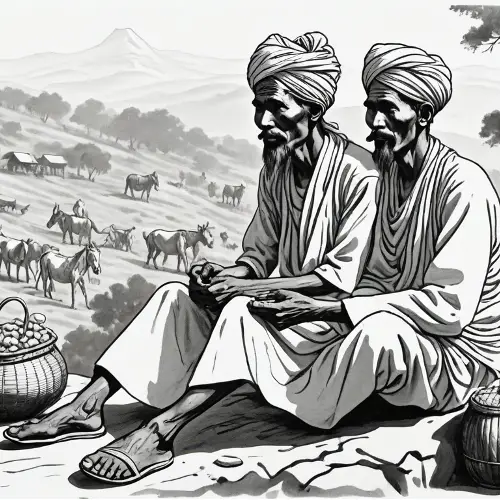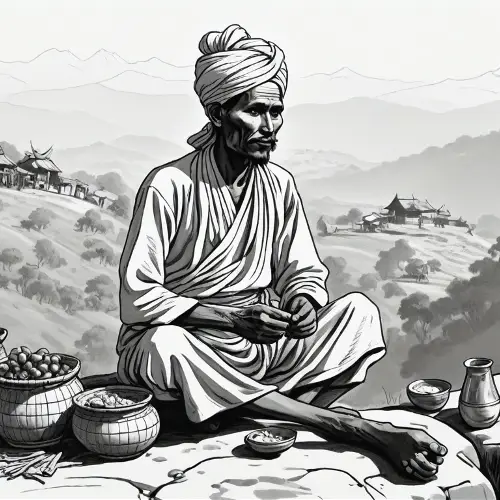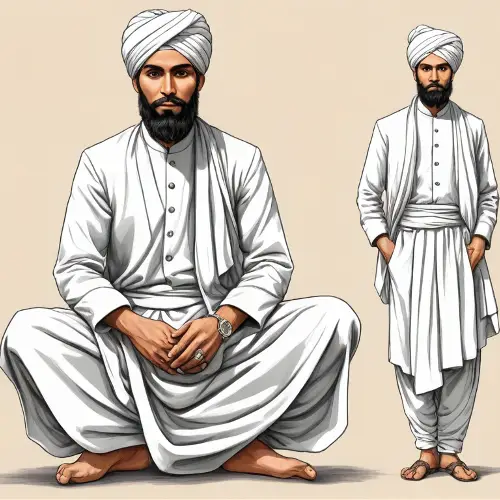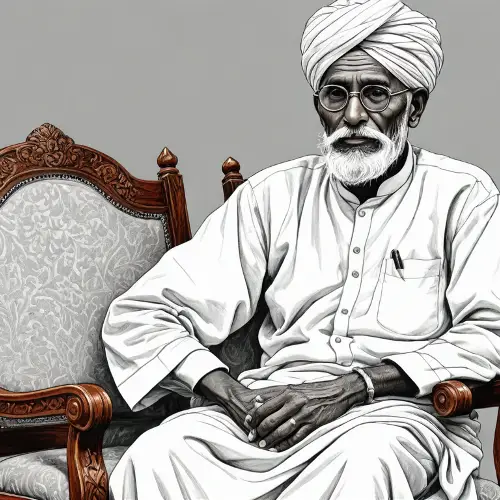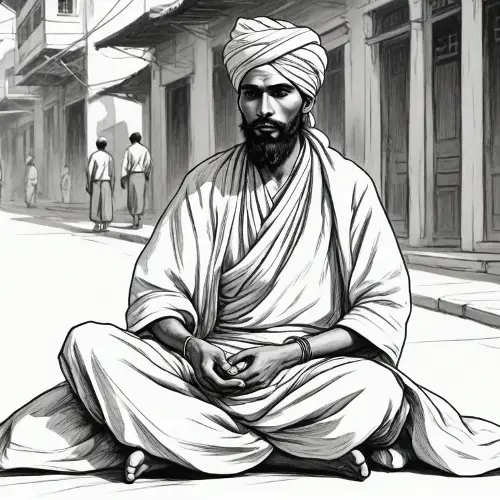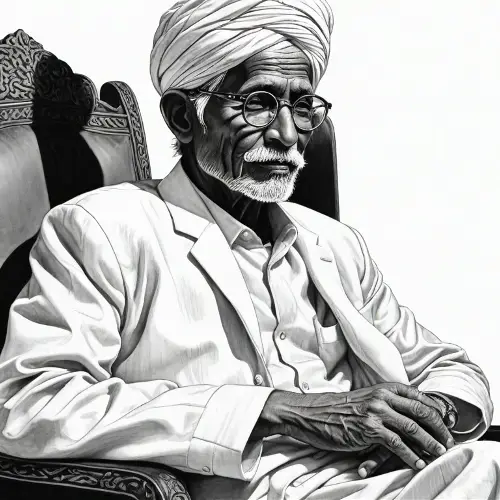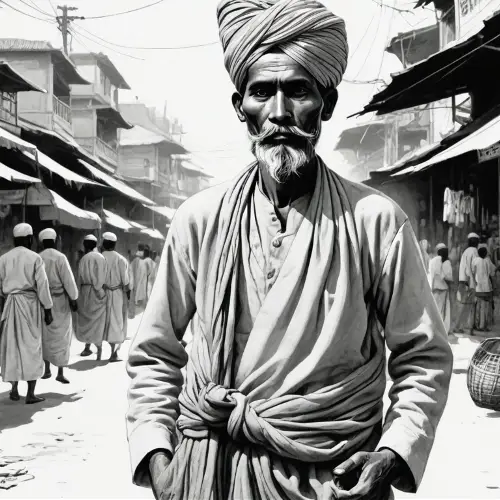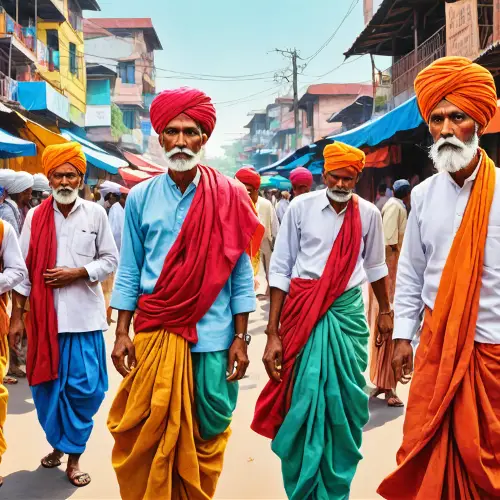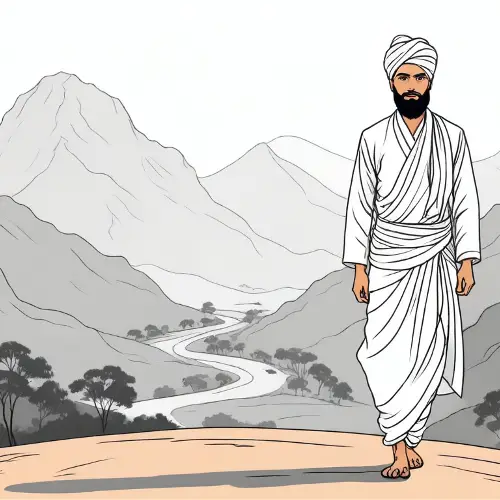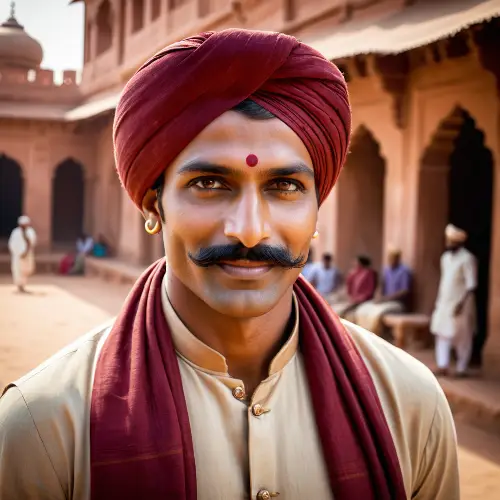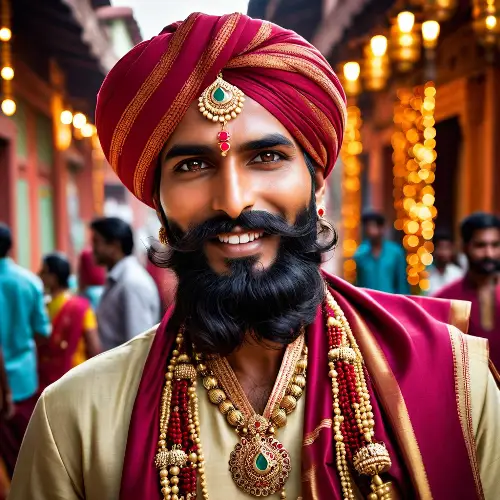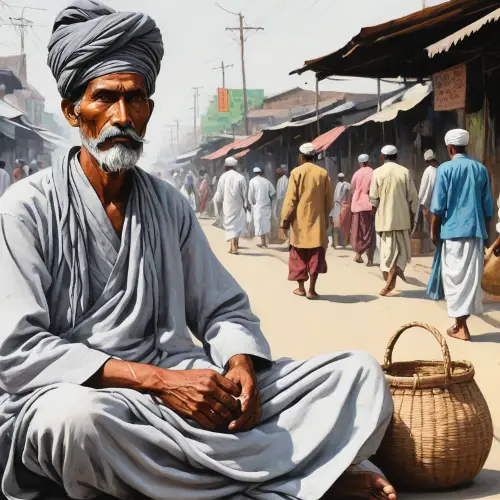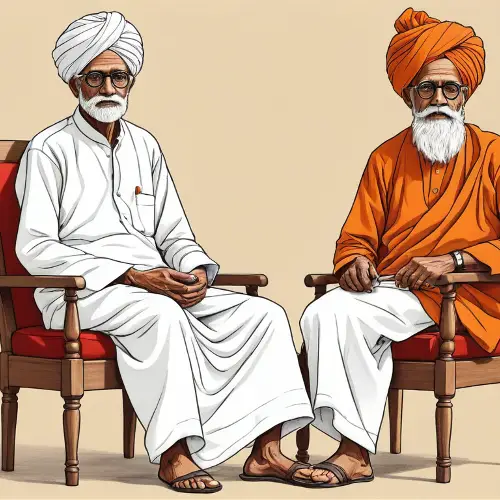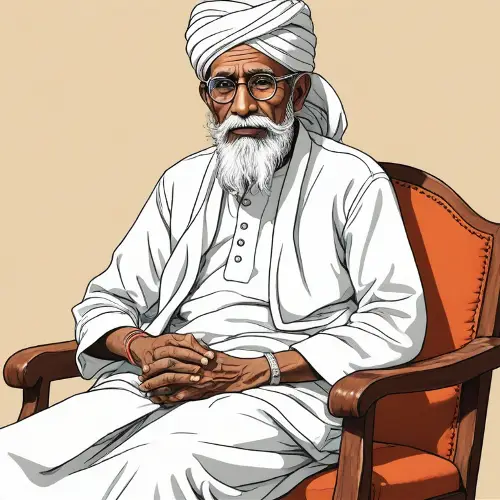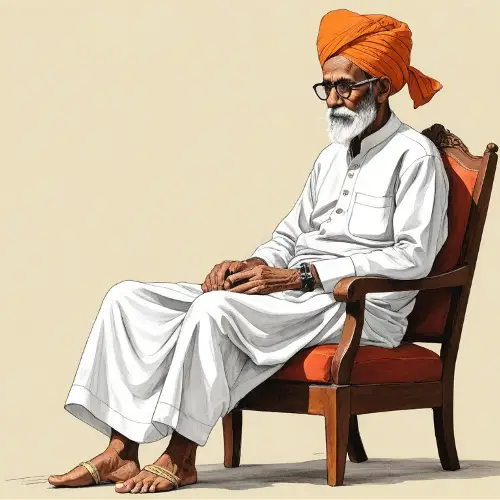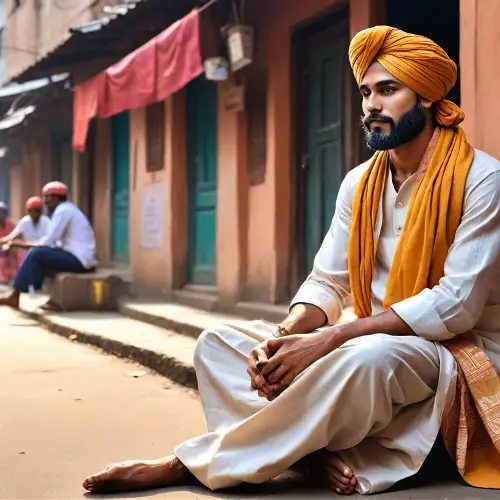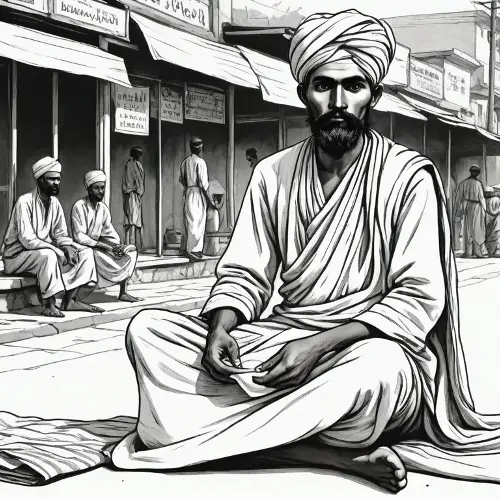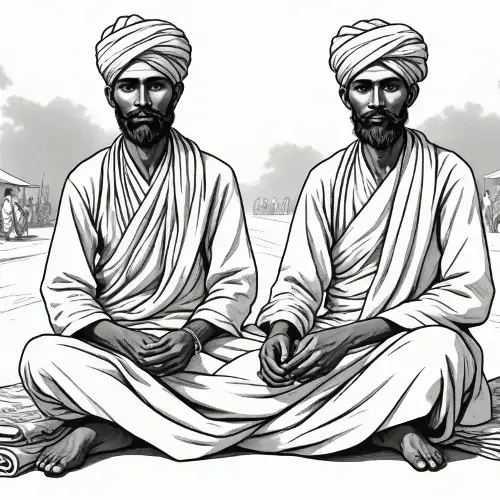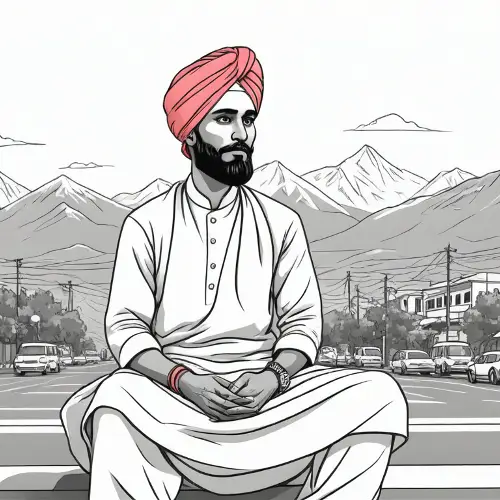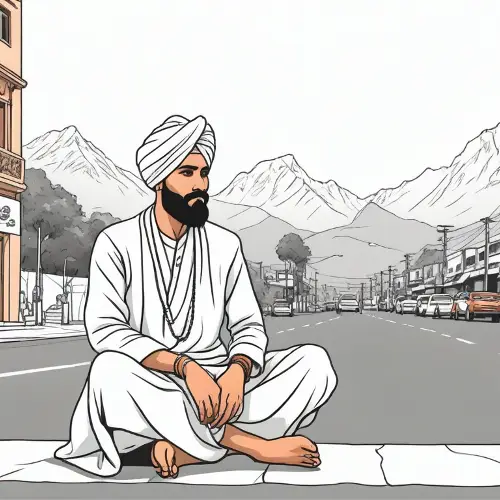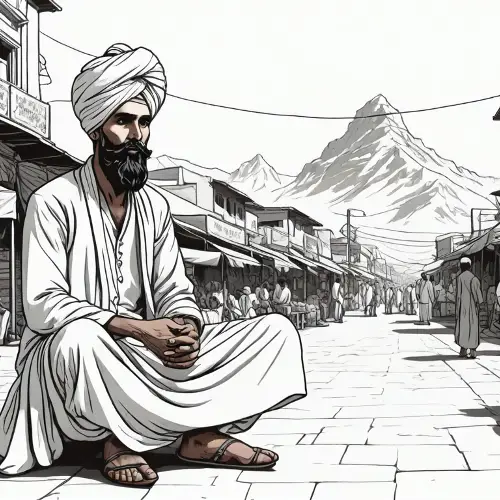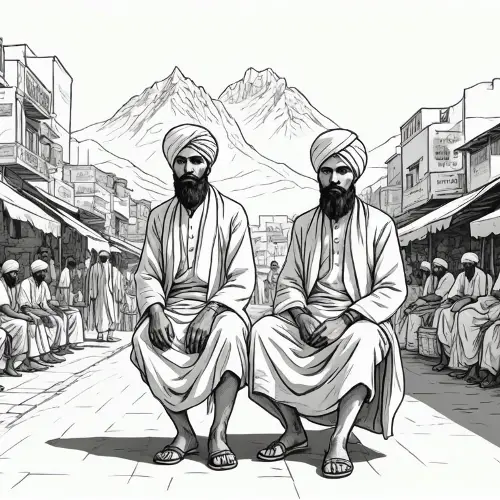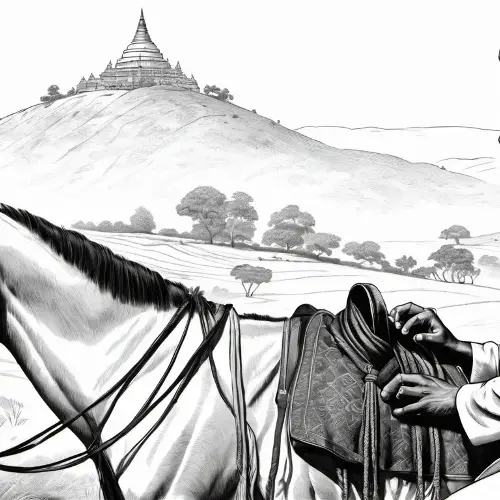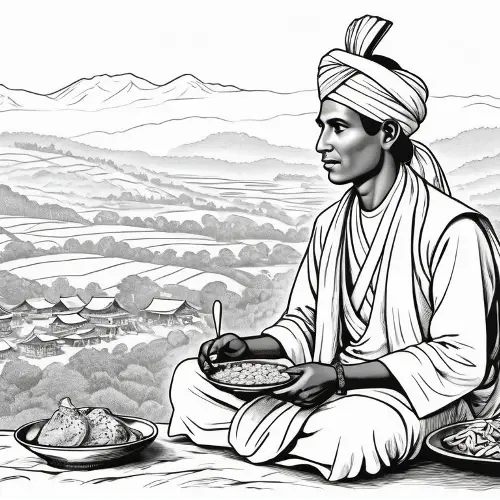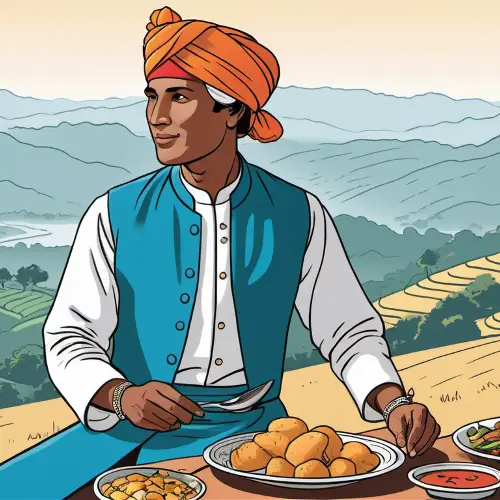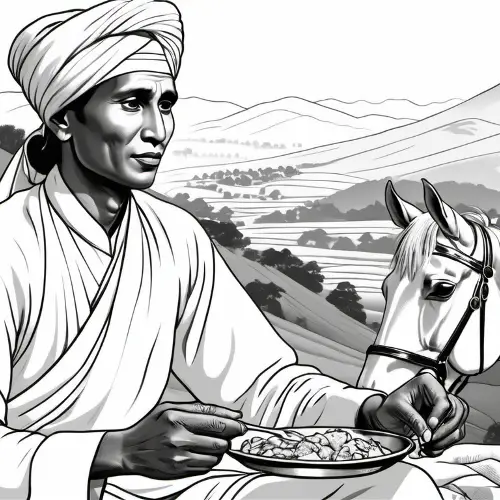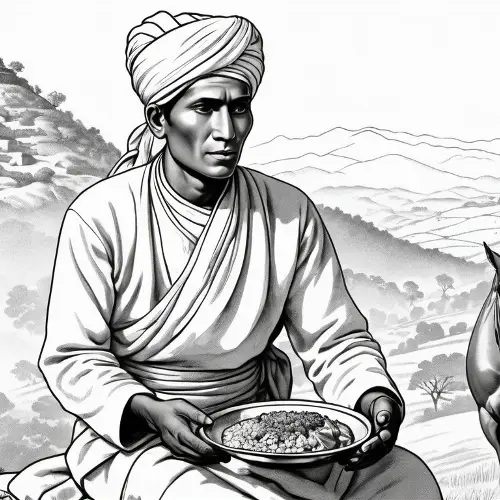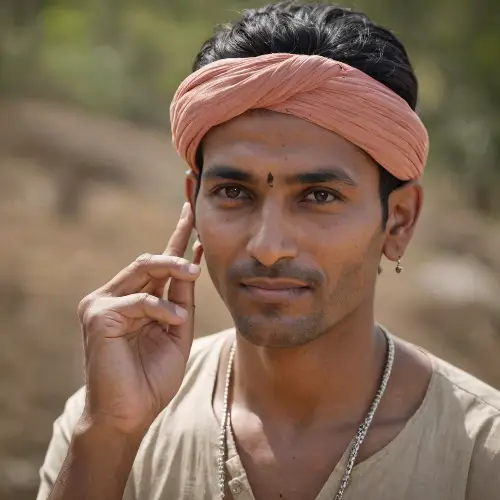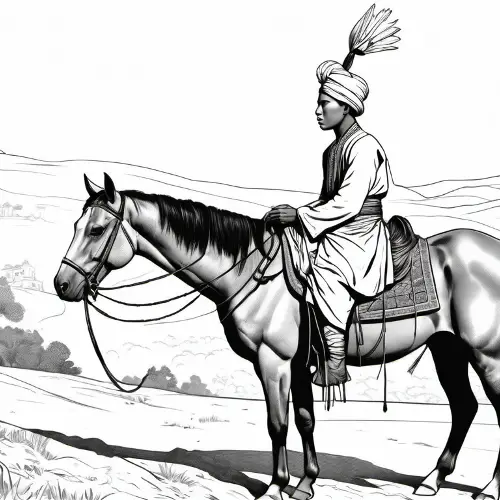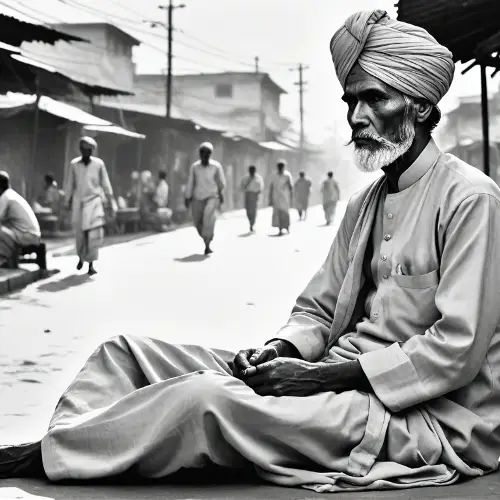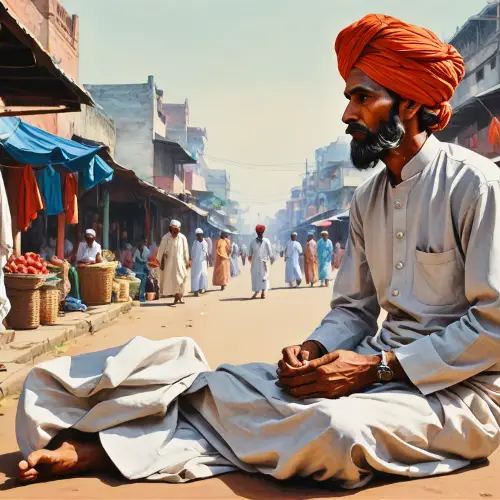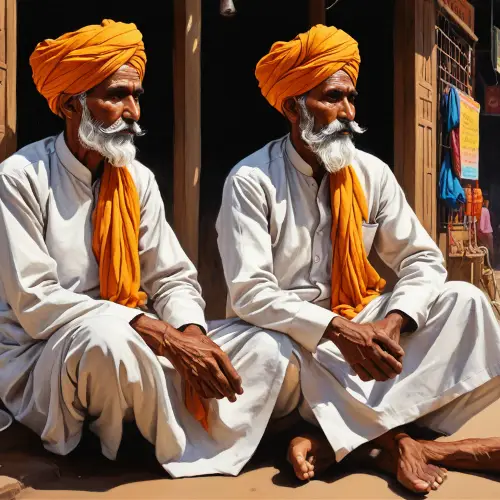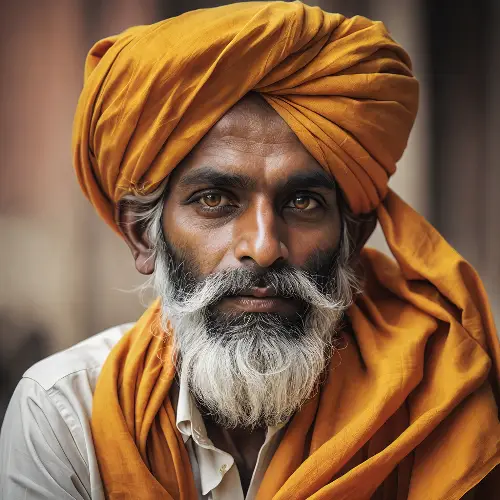an indian rajasthani man from 1800s travelling through hills. he wears white dhoti and a rajasthani turban, black and white sketch
More Like This
side view of an indian rajasthani man from 1800s travelling through hills. he wears white dhoti and a rajasthani turban, black and white sketch
indian man walking on a road with traditional rajasthani turban in 1930. charcoal style
indian man walking on a road with traditional rajasthani turban in 1930. charcoal style
indian man wearing dhoti and kurta with white headband on head in year 1930 walking on a road. charcoal style
indian man with traditional rajasthani turban walking on road. charcoal.
indian man walking on a busy road with traditional turban in 1930. charcoal style
indian man with no beard wearing dhoti and kurta with white headband on head in year 1930 walking on a road. charcoal style
Imagine an Indian man in the hilly region of Burma in 1880. Hes sitting on a rock or a simple surface, wearing a MARWADI THIN turban and a traditional doti. The man is depicted enjoying a meal in a serene setting. Beside him, a mule is securely tied, and luggage is neatly arranged, indicating a moment of rest during a journey. The hilly landscape features rugged terrains with greenery and perhaps a glimpse of a winding trail or distant hills. This scene captures a peaceful moment in the daily life of an individual in the hill areas of Burma during the late 19th century.
Imagine an Indian man in the hilly region of Burma in 1880. Hes sitting on a rock or a simple surface, wearing a turban and a traditional doti. The man is depicted enjoying a meal in a serene setting. Beside him, a mule is securely tied, and luggage is neatly arranged, indicating a moment of rest during a journey. The hilly landscape features rugged terrains with greenery and perhaps a glimpse of a winding trail or distant hills. This scene captures a peaceful moment in the daily life of an individual in the hill areas of Burma during the late 19th century.
30 year old rajasthani man walking on the hills of myanmar, he is a trader and does trading of cloths, he is wearing long white shirt of old style in india. he also wears dhoti. make sure his side face can only be seen.
To create a line art sketch of a Marwadi man wearing a turban, dhoti, and kurta, seating on a wide street of Burma in 1880 while selling cloth material, you can follow these steps: Basic Outline: Start with a rough outline of the seated man. Capture the pose with a half-seated position, focusing on the turban, dhoti, and kurta. Clothing Details: Add details to the clothing, emphasizing the folds and patterns of the dhoti and kurta. Pay attention to the turban, ensuring it reflects the traditional style. Seating Position: Define the seating position by sketching the ground or a makeshift seating arrangement. Consider adding a simple depiction of the cloth materials around the man. Street Details: Expand the sketch to include the wide street. Illustrate the ground, and add elements like cobblestones or patterns to suggest the historical setting. Include a hint of surrounding buildings or shops. Cloth Materials: Draw the cloth materials displayed for sale. Use lines and shading to convey the textures and patterns of the fabrics. Consider adding folds and drapes to make the textiles appear realistic. Facial Features: Add facial features to the man, focusing on his expression. Capture the sense of engagement and perhaps a welcoming or contemplative expression. Final Details: Refine the sketch by adding finer details, such as accessories, patterns on the clothing, and any additional elements that enhance the overall composition. Remember, this is a simplified guide, and you can adjust the details based on your preferences and artistic style. Feel free to experiment with different line weights, shading techniques, and textures to bring your sketch to life.
\"Generate a finely detailed line drawing depicting a 60-year-old Marwari man seated on a Burmese comfort chair, showcasing his side profile. The man is attired in a classic dhoti, complemented by a white Rajasthani turban. Pay special attention to the folds and textures of the dhoti, and capture the intricate details of the turban. Ensure that the man's spectacles are intricately portrayed, and emphasize the cultural fusion in this cross-cultural representation. Utilize precise lines and shading to convey the essence of the man's attire and the unique Burmese comfort chair.\" pencil drawing.
LINE ART SKETCH OF MAN WEARING TURBAN DHOTI KURTA SEATING ON HALF SEATED POSITION ON STREET OF BURMA IN 1880
Generate a finely detailed line drawing depicting a 60-year-old Marwari man seated on a Burmese comfort chair, showcasing his side profile. The man is attired in a classic dhoti, complemented by a white Rajasthani turban. Pay special attention to the folds and textures of the dhoti, and capture the intricate details of the turban. Ensure that the mans spectacles are intricately portrayed, and emphasize the cultural fusion in this cross-cultural representation. Utilize precise lines and shading to convey the essence of the mans attire and the unique Burmese comfort chair.
Generate a finely detailed line drawing depicting a 60-year-old Marwari man seated on a Burmese comfort chair, showcasing his side profile. The man is attired in a classic dhoti, complemented by a white Rajasthani turban. Pay special attention to the folds and textures of the dhoti, and capture the intricate details of the turban. Ensure that the mans spectacles are intricately portrayed, and emphasize the cultural fusion in this cross-cultural representation. Utilize precise lines and shading to convey the essence of the mans attire and the unique Burmese comfort chair. make line drawing.
Generate a finely detailed line drawing depicting a 60-year-old Marwari man seated on a Burmese comfort chair, showcasing his side profile. The man is attired in a classic dhoti, complemented by a white Rajasthani turban. Pay special attention to the folds and textures of the dhoti, and capture the intricate details of the turban. Ensure that the mans spectacles are intricately portrayed, and emphasize the cultural fusion in this cross-cultural representation. Utilize precise lines and shading to convey the essence of the mans attire and the unique Burmese comfort chair.
Create a detailed line art sketch depicting a Marwadi man wearing a traditional dhoti, kurta, and a turban on his head, engaged in selling cloth materials on a bustling market road in Mandalay in the year 1880. Capture the intricacies of his attire, the textiles on display, and the historical charm of the market surroundings. Pay special attention to the expression on the merchants face and the unique features of the Mandalay streetscape during this period. Highlight the cultural richness and trade dynamics in this vivid snapshot of 1880 Mandalay. CHARCOAL
Sketch a vibrant scene set in the bustling streets of Mandalay in 1880, where a Marwadi man, adorned in traditional attire—a dhoti, kurta, and turban—is passionately engaged in selling wares on a lively market road. Detail the Marwadi mans clothing with cultural accuracy, emphasizing the intricate folds of the dhoti, the design of the kurta, and the artistry of the turban on his head. Capture the essence of the vibrant textiles he is offering, with vivid colors and textures that stand out against the backdrop of the market. Illustrate the market road in Mandalay, portraying historical elements such as architectural styles, street vendors, and people engaged in various activities. Convey the energy of the bustling market, with diverse stalls and passersby creating a lively atmosphere.
marmadi man wearing turban dhoti and kurta front view walking in burma mountain hills
The image captures a confident and dignified Indian man. His complexion reflects the rich diversity found in India, ranging from fair to olive or darker tones. He may be wearing traditional Indian attire, such as a kurta or sherwani, adorned with intricate patterns, vibrant colors, or subtle earthy tones. His clothing might be complemented by accessories like a turban, scarf, or jewelry, offering a glimpse into the cultural richness of the region. His facial features could include expressive dark eyes, a well-groomed mustache or beard, and perhaps a bindi or tilak on his forehead, indicating cultural or religious significance. A warm and welcoming smile might convey a sense of hospitality and friendliness. The background of the image might feature elements of Indian culture, such as traditional architecture, lush landscapes, or symbolic artifacts. Overall, the image would encapsulate the essence of India's diverse cultural heritage and the individual's unique personality and style.
The image captures a confident and dignified Indian man. His complexion reflects the rich diversity found in India, ranging from fair to olive or darker tones. He may be wearing traditional Indian attire, such as a kurta or sherwani, adorned with intricate patterns, vibrant colors, or subtle earthy tones. His clothing might be complemented by accessories like a turban, scarf, or jewelry, offering a glimpse into the cultural richness of the region. His facial features could include expressive dark eyes, a well-groomed mustache or beard, and perhaps a bindi or tilak on his forehead, indicating cultural or religious significance. A warm and welcoming smile might convey a sense of hospitality and friendliness. The background of the image might feature elements of Indian culture, such as traditional architecture, lush landscapes, or symbolic artifacts. Overall, the image would encapsulate the essence of India's diverse cultural heritage and the individual's unique personality and style.
Create a detailed line art sketch depicting a Marwadi man wearing a traditional dhoti, kurta, and a turban on his head, while sitting on a road and engaged in selling cloth materials on a bustling market road in Mandalay in the year 1880. Capture the intricacies of his attire, the textiles on display, and the historical charm of the market surroundings. Pay special attention to the expression on the merchants face and the unique features of the Mandalay streetscape during this period. Highlight the cultural richness and trade dynamics in this vivid snapshot of 1880 Mandalay. charcoal.
Create a minimalist one-line sketch featuring a 60-year-old Marwari man in a dhoti and Rajasthani turban, seated on a Burmese comfort chair with a side view. Highlight the essential details such as the turban, dhoti folds, and the silhouette of spectacles, capturing the fusion of Marwari and Burmese cultural elements in a single continuous line. line sketch
Create a minimalist one-line sketch featuring a 60-year-old Marwari man in a dhoti and Rajasthani turban, seated on a Burmese comfort chair with a side view. Highlight the essential details such as the turban, dhoti folds, and the silhouette of spectacles, capturing the fusion of Marwari and Burmese cultural elements in a single continuous line
\Produce a simple pencil drawing of a 60-year-old Marwari man seated on a Burmese comfort chair. The side view should showcase him in a dhoti, wearing a Rajasthani turban and spectacles. Keep the drawing clean and straightforward, emphasizing the texture of the dhoti folds, the details of the turban, and the mans profile with minimal shading.\
MARWADI MAN WEARING DHOTI AND KURTA AND TURBAN ON HEAD SELLING ON MARKET ROAD IN MANDLAY IN 1880. side view. charcoal style
Sketch a dreamlike scene where a Marwadi man, adorned in a turban, dhoti, and kurta, is seated on a quaint Burmese road, surrounded by an ethereal atmosphere. The focus is on the serene moment as he passionately sells cloth materials, creating a captivating blend of cultural richness and historical charm. Detail the Marwadi mans traditional attire, paying special attention to the flowing dhoti, intricately wrapped turban, and the details of his kurta.
Sketch a dreamlike scene where a Marwadi man, adorned in a turban, dhoti, and kurta, is seated on a quaint Burmese road, surrounded by an ethereal atmosphere. The focus is on the serene moment as he passionately sells cloth materials, creating a captivating blend of cultural richness and historical charm. Detail the Marwadi mans traditional attire, paying special attention to the flowing dhoti, intricately wrapped turban, and the details of his kurta.
MARWADI MAN WEARING DHOTI KURTA AND TURBAN SEATING ON ROAD AND SELLING CLOTH MATERIAL IN BURMA IN 1885
MARWADI MAN sitting and WEARING DHOTI AND KURTA AND TURBAN ON HEAD SELLING ON MARKET ROAD IN MANDLAY IN 1880. side view. charcoal style.
Imagine a scene in the hill area of Burma in the year 1880. A distinguished man is depicted, wearing a traditional turban, kurta, and dhoti, standing with a sense of grace. His attire is detailed, reflecting the cultural nuances of the region during that period. Beside him, a mule is tethered. The landscape around is hilly, with lush vegetation and perhaps a glimpse of distant mountains. The man may be holding a piece of luggage or engaged in an activity, further emphasizing the context of life in Burma during the late 19th century.
Imagine a scene in the hill area of Burma in the year 1880. A distinguished man is depicted, wearing a traditional turban, kurta, and dhoti, standing with a sense of grace. His attire is detailed, reflecting the cultural nuances of the region during that period. Beside him, a mule is tethered, carrying goods or belongings, adding an element of daily life in the hills. The landscape around is hilly, with lush vegetation and perhaps a glimpse of distant mountains. The man may be holding a piece of luggage or engaged in an activity, further emphasizing the context of life in Burma during the late 19th century.
Imagine a scene in the hill area of Burma in the year 1880. A distinguished man is depicted, wearing a traditional turban, kurta, and dhoti, standing with a sense of grace. His attire is detailed, reflecting the cultural nuances of the region during that period. Beside him, a mule is tethered, carrying goods or belongings, adding an element of daily life in the hills. The landscape around is hilly, with lush vegetation and perhaps a glimpse of distant mountains. The man may be holding a piece of luggage or engaged in an activity, further emphasizing the context of life in Burma during the late 19th century.
Imagine a scene in the hill area of Burma in the year 1880. A distinguished man is depicted, wearing a traditional turban, kurta, and dhoti, standing with a sense of grace. His attire is detailed, reflecting the cultural nuances of the region during that period. Beside him, a mule is tethered, carrying goods or belongings, adding an element of daily life in the hills. The landscape around is hilly, with lush vegetation and perhaps a glimpse of distant mountains. The man may be holding a piece of luggage or engaged in an activity, further emphasizing the context of life in Burma during the late 19th century.
marwadi turban man wearing dhoti and kurta seating on wide street market selling clothes with mountain background in 1887
marmadi man wearing turban dhoti and kurta front view walking in desert
marwadi turban man wearing dhoti and kurta seating on wide street with mountain background
line art sketch featuring marwadi man half steated facing left and selling cloth material on wide busy street in 1885
marwadi turban man wearing dhoti and kurta seating on wide street market selling clothes with mountain background in 1887
Generate evocative and historically accurate images depicting a indian man wearing a turban peacefully eating in the serene hills of Myanmar in the year 1837, with his horse tied nearby. Capture the tranquility of the moment, emphasizing the cultural significance of the turban, the traditional attire, and the picturesque Myanmar hills. Pay meticulous attention to historical details, including clothing styles, landscape features, and the interaction between the man, his meal, and the tied horse. Convey the timeless connection between individuals, nature, and animals within the historical context of Myanmar in 1837
Generate vivid and historically accurate images capturing an Indian man with a turban enjoying his food in the peaceful hills of Myanmar in 1837. Illustrate the cultural fusion through the traditional Indian turban and attire against the scenic backdrop of Myanmar. Pay meticulous attention to historical details, such as the mans clothing, the serene hills, and the horse positioned closely nearby. Convey the harmonious and cross-cultural ambiance of the moment, where the man, his food, and the horse coexist in the tranquil beauty of the Myanmar hills during the 19th century
Generate vivid and historically accurate images capturing an Indian man with a turban enjoying his food in the peaceful hills of Myanmar in 1837. Illustrate the cultural fusion through the traditional Indian turban and attire against the scenic backdrop of Myanmar. Pay meticulous attention to historical details, such as the mans clothing, the serene hills, and the horse positioned closely nearby. Convey the harmonious and cross-cultural ambiance of the moment, where the man, his food, and the horse coexist in the tranquil beauty of the Myanmar hills during the 19th century
\Generate compelling and historically accurate images depicting an Indian man, adorned in a turban, peacefully eating in the scenic hills of Myanmar in the year 1837, with his horse tied nearby. Capture the cultural fusion of Indian attire against the backdrop of the Myanmar landscape, emphasizing the traditional elements of the turban, clothing, and the serene hills. Pay meticulous attention to historical details, including clothing styles, landscape features, and the harmonious interaction between the man, his meal, and the tied horse. Convey the cross-cultural essence of the moment within the historical context of Myanmar in 1837
Title: \Roadside Elegance: Marwadi Merchant in Mandalay, 1880\ Description: Sketch a serene side view of a Marwadi man, elegantly seated on the bustling market road of Mandalay in 1880. The focus is on capturing the quiet dignity and cultural richness of the merchant as he faces left, surrounded by the energy of the vibrant marketplace. Detail the Marwadi mans attire with precision, emphasizing the graceful folds of the dhoti, the intricate patterns of the kurta, and the distinctive style of the turban on his head. Illustrate the textiles he is selling, playing with colors and textures to evoke the vibrancy of the market. Frame the scene to showcase the historical elements of the Mandalay market road, including nearby stalls and architectural details that transport viewers to the late 19th century. Convey the movement of people passing by, creating a sense of the lively street environment. Highlight the Marwadi merchants profile, capturing the expressions on his face as he engages with customers and manages his goods. Utilize shading and lighting to add depth and atmosphere, creating a visually compelling side view of the cultural exchange taking place on the historic road. This sketch aims to immerse viewers in the elegance and cultural significance of a Marwadi merchant seated on a Mandalay road in 1880, offering a glimpse into the timeless beauty of this historical moment. black and white. greyscale
Title: \Roadside Elegance: Marwadi Merchant in Mandalay, 1880\ Description: Sketch a serene side view of a Marwadi man, elegantly seated on the bustling market road of Mandalay in 1880. The focus is on capturing the quiet dignity and cultural richness of the merchant as he faces left, surrounded by the energy of the vibrant marketplace. Detail the Marwadi mans attire with precision, emphasizing the graceful folds of the dhoti, the intricate patterns of the kurta, and the distinctive style of the turban on his head. Illustrate the textiles he is selling, playing with colors and textures to evoke the vibrancy of the market. Frame the scene to showcase the historical elements of the Mandalay market road, including nearby stalls and architectural details that transport viewers to the late 19th century. Convey the movement of people passing by, creating a sense of the lively street environment. Highlight the Marwadi merchants profile, capturing the expressions on his face as he engages with customers and manages his goods. Utilize shading and lighting to add depth and atmosphere, creating a visually compelling side view of the cultural exchange taking place on the historic road. This sketch aims to immerse viewers in the elegance and cultural significance of a Marwadi merchant seated on a Mandalay road in 1880, offering a glimpse into the timeless beauty of this historical moment.charcoal style.
















